
Andrew Schwerin
Eureka Springs, Arkansas
Mixed vegetables, berries, and lamb
Deep straw mulch, occultation
ANDREW SCHWERIN AND HIS WIFE MADELEINE GROW mixed vegetables and berries on Sycamore Bend Farm in Eureka Springs in northwest Arkansas, close to Fayetteville. They have about an acre of permanent vegetable beds that are four feet wide and 100 to 150 feet long, plus a greenhouse and a high tunnel. I caught up with Andrew over the phone in the spring of 2018 because I wanted to hear how he managed his deep straw mulch system.
“I had moved to Eureka Springs, and I had this long-term plan to start a plant nursery. Around the second year that I was here, I was working odd jobs and building up plants, and a friend introduced me to Patrice [Gros’s Foundation] Farm. I just felt that I needed to learn farming, and it happened to be no-till,” said Andrew.
“It sounds like you’re doing a system that’s similar to what Patrice was doing at his farm on your own farm. Are you using his system, or did you make modifications to it?” I asked.
“My system is very close to Patrice’s. I’d say the most significant difference would be that I don’t have grass paths, which is a pretty minor detail. At the same time, Patrice brought a lot of ideas from Dripping Springs Garden [also in Arkansas]. And of course, then they got a lot of stuff from the basic Eliot Coleman methods of how to do intensive gardening. So it’s all evolved, and taken different pathways,” said Andrew.
“Would you describe the methods that you’re using now?” I asked.
“To summarize, it would be straw mulch and weed management. Usually, people have to till because there are too many weeds, right? If I have, say, a lettuce crop and I harvest all the lettuce, and then I have an empty bed, we’re going to have a few weeds in there. In that case, if there’s spring lettuce, and I was going to plant sweet potatoes, which I will be doing this year, I would use black plastic. Occultation is another name for it,” said Andrew.
“Have you gotten to the point where your weed pressure is pretty low, and you can go from one crop to another without weeding or cultivating?” I asked.
“I think so. Overall, weeds are a very low-priority problem for us. It’s still more than what the workers want to handle. We do hand weeding for things that we don’t have mulch on. For example, the carrots would be one,” said Andrew.
“We would just hand weed, or with a little Japanese hand hoe, to get the weeds in between the carrots. On a larger scale, a person could still cultivate that, without a tiller, just using a finger weeder or something like that. There are a lot of options out there.”
“So have you been able to work your weed seed bank down so there just aren’t that many weeds germinating anymore?” I asked.
“Yes, that’s what I’m going for. And I believe I’m doing that. I don’t know if all my workers agree with that belief. But yes, I’m very adamant about not letting any weeds go to seed in the garden,” said Andrew.

Sweet potatoes to the left, fall garden on the right.
Credit: Andrew Schwerin
“There are weeds like henbit, which aren’t so bad. One we do have continual problems with is carpetweed. That one takes a lot of our attention, and dandelions. I’ve given up on dandelions this year. I’ve kept them out of the garden for four years, by spending a lot of time taking them out, around the garden, but they win.”

What the beginning of the season looks like for sweet potatoes in Sycamore Bend’s system.
Credit: Andrew Schwerin

This is what rolling straw mulch out in the fall on Sycamore Bend Farm looks like.
Credit: Andrew Schwerin
“I know that Patrice used a lot of straw mulch, almost as a form of occultation to keep the soil covered and keep it from growing weeds over the winter. Is that what you do?” I asked.
“Yes, absolutely,” said Andrew.
“And so, you leave everything covered, and you have permanent beds, and you just pull the straw back to expose fairly weed-free soil when it’s time to plant?” I asked.
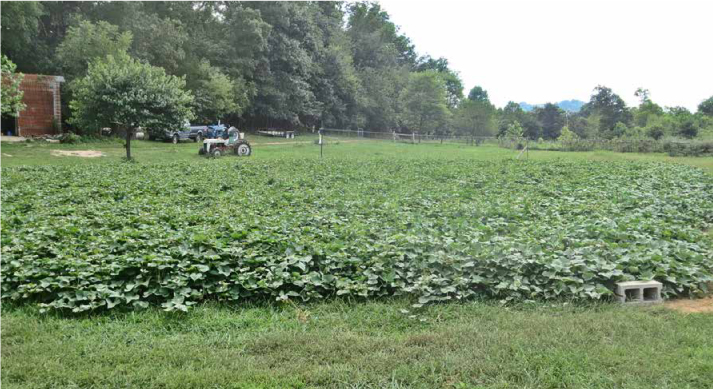
Six foot bed spacing is completely hidden in August, controlling most weeds.
Credit: Andrew Schwerin
You can see how the straw is suppressing the weeds before the sweet potatoes overgrow and start smothering weeds.
Credit: Andrew Schwerin
“Exactly. So this time of year [spring], we’re usually trying to pull the mulch back about three days before we’re seeding, or transplanting, just to let the soil warm up a little bit more; because it stays cooler underneath the mulch. But we don’t want to do it earlier, because we don’t want the weed seeds to get a head start. And in case we have heavy rains, to avoid erosion,” said Andrew.
“So you must be buying a lot of straw?” I asked.
“I reckon it’s probably about $750 a year, for one acre. I use large, round bales instead of the square bales that Patrice was using. A round bale covers about 200 feet,” said Andrew.
“So you’re pulling the straw back to expose the bed for planting. Are you leaving the straw in the pathways, or do you mulch back around the crop during the growing season?” I asked.
“If it’s a long-term crop, we bring it into the pathway, and it’s there for, usually, a few weeks. Then we bring it back into the bed. For crops that we are planting closely, if I’m doing something like radishes, or if I’m transplanting lettuce, the straw doesn’t go back into the bed, because those crops are so densely planted,” said Andrew.
“If it’s something like tomatoes or peppers, we don’t take the straw all the way off the bed. We just dig a little hole, where the plant is going to go, and we plant the seedling through the hole in the straw. And then, there’s a big middle ground. Kale and broccoli are ones where we mostly clear the bed. We transplant, as they get bigger, three weeks down the road, then we re-mulch them. So they’re mostly weed free for the season.”
“What are the challenges with the deep straw mulch system?” I asked.
“The main thing with the straw is removing it. And this is mostly for scaling it up; I don’t consider it a problem here. If it’s not going to go back in the beds, we don’t want to just leave it in the pathways, because it can get piled too high. This is where I have this idea, I wish I could find out if somebody has tried it, of running a hay baler through [to pick up] the straw, and then you have bales of hay at the end, which you can move elsewhere,” said Andrew.
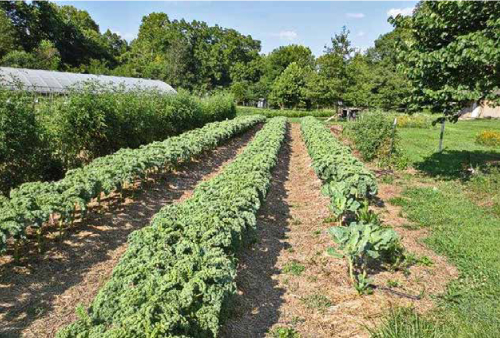
Summer kale showing weed suppression.
Credit: Andrew Schwerin
“So often we will make a big pile at the end of the bed, and a few months down the road, we’ll need that, and we’ll move it somewhere else in the garden. But that’s a lot of labor. It’s not a lot at our scale, but it would be a large amount if you were doing seven acres, or something like that.
“It doesn’t take any longer to roll out a bale of straw than it does to get the tiller out and go up and down the beds with it. People have this need to go into their garden in the springtime and get rid of all the weeds, and I don’t think they’re taking into account the cost of cultivation, when they say that the straw costs too much. Because it would save a lot of money by using it, and it’s easier to save money than make money on a farm.”
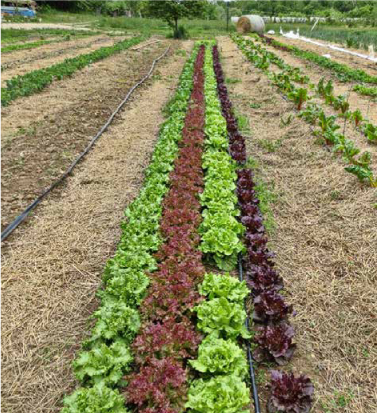
Mulched weed control in greens crops.
Credit: Andrew Schwerin
“What’s your advice for somebody trying to get started with no till?” I asked.
“My recommendation would be to use straw mulch, and start it the year before, or at least, the fall before they want to plant. If you’re putting it on in the spring, it’s just going to be really hard to take care of it. You’re going to have too many weeds, which are already established, coming through. So it really has to get on before winter starts,” said Andrew.
“That makes sense. I’ve heard similar advice, to get started ahead of time with no-till, from other people,” I said.
“If they’re using plastic [for occultation or solarization], there’s still the issue of what happens when you take the plastic off to plant. Then those weeds are going to come fast. So the mulch is good for being able to continually keep the weeds down. I’m really pro-straw, instead of anti-till,” said Andrew.
“I know you said that you run the rototiller over your beds, just really shallowly, almost using it like a Tilther to fluff up the soil surface, from time to time. What does that do? Why do you still do that little amount of rototilling?” I asked.
“It’s to incorporate raw manure. A lot of the nitrogen will [volatilize] if it’s not buried right away. So I like to get, at least, dust covering it, so that it can [get in] the soil immediately, instead of sitting on top, drying out,” said Andrew.
“Can you estimate how deeply you run that rototiller?” I asked.
“Since it’s not tilled much, it doesn’t go that deep. About one inch. I don’t have to do that all the time. For example, if I’m putting the manure on in the fall, then I don’t need to till, if I’m putting the straw on right after the manure,” said Andrew.
“Is there anything else I should have asked you, or anything else you want to say about no-till?” I asked.
“Your big question was, difficulties and successes, and I’d say, overall, it’s successful. I’m happy with this. Maybe you should ask me in midsummer. I’ve never thought of changing, and it’s not because I’m stubborn. It’s just working,” said Andrew.

Summer lettuce, with lots of tomatoes and cucumbers, squash, potatoes, and other greens.
Credit: Andrew Schwerin
Dan Heryer and Brooke Selvaggio
Kansas City, Missouri
Mixed vegetables
Applied organic mulch/straw
I SPOKE WITH DAN HERYER OF URBAVORE FARM IN Kansas City, Missouri, late in November 2017. I had heard about Dan and wife Brooke Selvaggio’s urban farming for a number of years. What I didn’t realize was that they were doing it without tilling, until someone said, “Well, have you talked to Dan and Brooke?”
After neighbors opposed their original in-city farm, they moved to a 13-acre parcel in the city and established a diversified farm with fruit trees, livestock, and no-till vegetables. That was a few years ago, so I wanted to check in and see how starting their farm over with no-till was going. The farm they built on scraped-off soil (including a former baseball diamond) inside city limits is unique and fascinating, and too complicated to fully detail here.
A number of articles have been written about Urbavore Farm’s transformations over the years, and they are well worth reading. We are going to focus pretty tightly in on their no-till system. To hear about the rest of their farm, listen to the Farmer to Farmer podcast they were on, or seek out one of the many articles about them.
“Why did you start with no-till and how did you come up with a method?” I asked.
“Shortly after Brooke and I first met a little over ten years ago, I started working as the farm manager for a local farm/nonprofit, which is now called Cultivate Kansas City. Back then it was Kansas City Urban Agriculture,” said Dan.
“When I was working for them, I attended a local growers conference for the Midwest region, and there just happened to be this guy from Arkansas, Patrice Gros, who has Foundation Farm. He spoke about his no-till method and how it was for him as far as the tilth-building, reduced labor, and the various aspects. His was a deep mulch system,” said Dan.
“I was very inspired by him and that year I managed the farm at Cultivate Kansas City. There was a guy there who had done your typical market gardening, and he was into trying other methods. He and I were interested in this no-till method, so we trialed a few beds in no-till and liked the results.
“The next year I started farming with Brooke, so we decided to just go for it and try to do no-till. At the time she was farming her grandfather’s backyard. It was probably an acre and a half in suburbia here in Kansas City.
“We decided to try doing no-till on the whole thing. On her grandfather’s land, we didn’t have any expenses, so we were able to take big risks. We did it over the course of two seasons and immediately ran into problems in terms of efficiencies and things like that. There were plants that were way too wet and cold, and that threw off all of our planting timing, everything that we had known.
“We started trying to figure out that learning curve. We were committed to it and we just kept going with it. Ours was a heavy organic matter, deep mulch sort of method at that point. We were using mulch on the beds that were previously tilled, and then we were using heavy, thick mulch to kill weeds. That was where we started out at, and did a lot of transplanting, and moved on from there.”
“The piece that you point out about figuring out how to do things with really low costs and as minimal investment as possible is something that really resonates with us. We did not want to get into debt over our farm. We felt like getting into debt was the surest way to fail. So we just were adamant that we were going to try to stay out of debt,” said Dan.
“We picked out the sites that had what seemed to be decent soil and reasonable slopes to work with, and those are what became the vegetable fields. We started out with four fields that were each a third of an acre. When we laid out our first field we had to look for mulch. We have a big brewery here in Kansas City called Boulevard Brewery. They were filtering their beer through these biodegradable filters and they were approximately three-and-a-half-foot squares. It was probably seven feet by three-and-a-half feet and they folded it up into squares, so there was a seam in the middle. So we would unfold these and make a row out of them, make a bed out of them essentially, and lay these down as sheet mulch,” said Dan.
“Then we would put straw on top of them. By themselves they really wouldn’t have been enough to kill established fescue and things like that, so we put straw on top of them, and it was a way of reducing the amount of straw we were using.
“We laid out the first plot like that and we left. We tried to leave grass strips between the rows, which was a bad idea. It was taking us too long to lay the rows out on that first field, so we decided to nix the aisles and just mulch the whole thing on the next field.
“Then at some point we left out the beer filters as well. It was a pain to try and get them here in one piece, so we decided to forget the beer filters and just lay the straw very thick, and that worked fine.
“By that time we had decided to keep the area in between rows of crops mulched. So we would clear the mulch off a four-foot area, expose the soil, and seed the whole bed of beets, for instance, or greens or something like that, anything that would be direct seeded. For the first season that’s a huge undertaking because you have such thick straw in there. We have four-foot beds and two-foot aisles. Some things like garlic, we’ll just plant a big block of garlic and won’t do an aisle.

Dan in the tomatoes and flowers.
Credit: Brooke Selvaggio
“We went and cleared off that four-foot section for the bed and you’d end up with such an absurd amount of mulch in the two-foot aisle that it was just impossible to deal with. We’re trying to adapt it to a more commercial scale, where we can really plant efficiently and not mess around with the straw too much. We want to do whatever is the most efficient without tilling, so we clear off beds and we will then have to weed those beds and manage them really well to make sure that weeds are at bay.

Here’s a row of onions transplanted into a break in the mulch.
Credit: Brooke Selvaggio
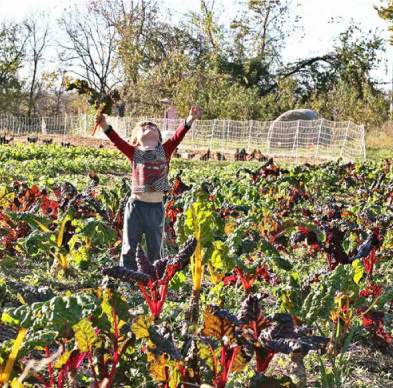
Enjoying the no-till chard.
Credit: Brooke Selvaggio
“There are an awful lot of things that we don’t direct seed, or that don’t require a full bed clearing. We just keep those in rows or seed them, open up a hole for more widely spaced stuff like summer squash or melons or stuff like that.
“Before we do anything, we’ll have a plan as to what’s going to be planted in the field, like most farmers would. We know what the layout of the field is ahead of time, and then we pound in T-posts and mark the edges of each bed, marking the aisles as well. Then any beds that are getting cleared off, we’re going to run a twine line from post to post and clear off that bed of straw and get down to bare soil with those twine lines as guides for what we’re doing.
“It’s the same thing for any other crop. We mark things out and T-post the beds. They’ll get pulled later and all those T-posts will then get thrown into tomato trellising and things like that. But that’s how we start out.
“With the melons and cucurbits it’s the same thing. Cucumbers, we would clear off two rows in a single bed instead of cleaning off the whole bed, because you want to keep things mulched so that the beds don’t get overtaken with weeds. We’re only going to do two rows of cucumbers in a four-foot area. We don’t like to space them any tighter than that, so we clear off two lines and they’ll probably be about nine inches wide. Just a straight line of bare soil. With the cucumbers we furrow a little bit in the soil for them straight down the row, seed them, and cover them with compost, like we do most of our direct-seeded crops.
“Now for something like summer squash, we do a single row per bed, two feet apart. So we have a measuring tape down, and run down the line and open up the holes first, and then take the measuring tape off and put down compost. Bring the tractor bucket over with the compost, scoop five-gallon pails out of the tractor bucket, and then go down the row. A bucket will probably do five or six holes, so that’s a lot of compost per hole.
“Then we would seed into that compost. Now depending on what kind of weather conditions we’re expecting, we might just put the seed in the compost with no soil contact, or we may flatten out the compost pile down there and have direct soil contact with the compost on top of it. So we’re poking the seed down accordingly, depending on how much moisture we’re expecting, because the compost can be quite dry and then sometimes it doesn’t germinate. We don’t irrigate at all, seeds are never going to see water other than rain. So if the compost is too dry, then [seeds won’t germinate].”
“But you smash it down if it’s going to be dry?” I asked.
“Yes. Our first planting, we probably just go ahead and do it in the compost and not do it on the soil. But in subsequent plantings of summer squash we would probably assume that it was going to be dry and press for soil contact. Just that little bit of moisture on the surface of the soil is going to be enough to germinate the seeds,” said Dan.

No-till furrows for direct seeding.
Credit: Brooke Selvaggio
“Then the transplanted crops work much the same way as for the summer squash. We put out the measuring tape, open up holes accordingly in the mulch, and then put our compost in the holes, and then we would take a trowel, or in the case of tomatoes we’ll take a shovel, and dig a hole. Not a deep hole, but it’s just more efficient with a shovel with the tomato hole.
“And we do our perennials the same sort of way. We are definitely in a transition with how we do things. We have had a huge amount of problems with perennial weeds, particularly bindweed and milkweed, so we are trying to figure out how to deal with that.
“We have some four-year-old plantings of strawberries that are getting kind of tired and they need to be replanted, so we are laying out an area for that as well. It’s been a while since we laid out a new area in sod. So we’re going to lay silage tarps on that. We have a couple of used billboard [covers] that we keep around for doing solarization in some areas when it gets out of control. Generally we don’t use tarps, but we’re moving in the direction of trying to use a little less mulch. We’re still using plenty of mulch, but we’re using tarps to reduce that need to some extent.”

A chicken tractor after the vegetable crop has come out.
Credit: Brooke Selvaggio
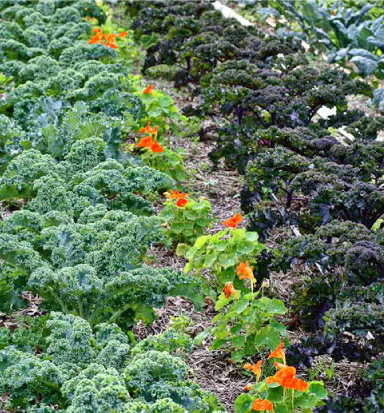
No-till kale and nasturtiums.
Credit: Brooke Selvaggio
“Are you familiar with [Anne and Eric] Nordell?” said Dan. “I really admire their cover cropping system and the way that they’ve reduced weed pressure on their farm. Obviously, the way that they’ve accomplished that is through tillage, and we want to mimic their cover cropping system with no-till. We want to try to cover crop at different times of the year and use the pigs to turn under those cover crops, and as a result kill different types of weed seeds over the course of many seasons.
“One of the things that’s important to their system is their fallow periods, where they let weed seeds germinate and then till them after they’ve germinated. That is something that is tricky to accomplish with no-till. So we’re hoping that once the pigs run an area, that we can use silage tarps to bare fallow, essentially. To let the weeds come up after the pigs are off, then tarp it and kill those weeds, and then either plant another cover crop or let the mulch sit and prepare for the next season.
“Our hope is that the pigs will be a game-changer as far as scalability goes. We hope to use them on areas that do need weed management. It certainly happens, especially with areas that we cover crop, where things get weedy and need to be dealt with in some fashion,” said Dan.
“Your basic options are to re-mulch it to a level that it’s going to kill it, or to hoe it up, which is what we do. We typically will just surface hoe any areas that get really weedy, and then we’re probably just hoeing the top inch of the soil. But it’s really prohibitive in terms of labor. Our hope is to turn things over without mechanical tillage, but with these animals. We did that with the chickens to some extent, but it can’t be too weedy for the chickens, because they can only handle so much.”
“On the Farmer to Farmer podcast you said to start off by putting a foot or a foot and a half, a lot of straw down. When you’re breaking in new ground, do you put down any fertilizer or compost or anything?” I asked.
“When we initially got here we limed the whole 13 acres, which without equipment was a huge pain. What we do for fertility is animal based, so we run the chickens. If there’s an area that we want to prep and fertilize for growing, then we will run the chickens on that area heavily and take the manure from their houses and spread it throughout the plot that we’re planning on mulching. And that’s the main source of fertility,” said Dan.
“Then the compost at planting supplements that, but we don’t just broadcast compost. What we use in our field we buy from a local company that produces finished compost. It is also food-based, so it’s pretty hot.”
“If you’re going to make a new patch you need to be thinking about it the previous year. There’s no equivalent in your system of plowing it up quickly, right?” I asked.
“It does definitely take long-term planning. You have to know what you’re doing. But we have the established plots, and those are a lot more flexible than a scenario where we want to plow new ground or something like that to put a crop in real quick. We can’t do that. We have to plan probably a year in advance and think, ‘Okay, we want to plant strawberries next spring, so we’re going to run the chickens heavily in the summer and then in the fall we’re going to mulch it and by spring it’ll be ready to plant,’” said Dan.
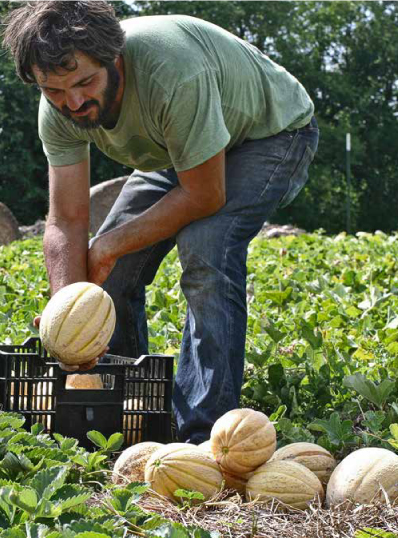
Harvesting no-till muskmelons.
Credit: Brooke Selvaggio
“We couldn’t farm that baseball diamond if we didn’t do no-till. If you plowed that up and tilled it, it would be a crusty clay mess and you couldn’t grow healthy crops in it. But our single best tomato crop that we’ve had on this farm was in that baseball area, and you just couldn’t do that in a tilled soil situation,” said Dan.
“We definitely have our problems, but our crops are really nutrient dense, really flavorful. The difference in the quality of the crops on all levels, as far as taste and aesthetics, is noticeable and noted by our customers. I don’t know exactly what’s happening underneath that straw, but I know it’s good. I know it works.
“In addition to the benefits of low cost as far as tractor and implements and startup and all that sort of stuff, the quality of the food that comes from a natural system is second to none. It’s really just very, very healthy, especially over the course of time. The plants get healthier. The soil gets healthier. Things are improved.
“There are problems. The bindweed is a huge problem, but it doesn’t really impact the health of the crops until it starts climbing on them. They’re still very happy and healthy living with the bindweed right next them. It doesn’t negate the fact that the health of the soil and the quality of the produce is absolutely worth whatever problems are there.
“We don’t irrigate and I think that is a major benefit. Irrigation costs a lot of money and a lot of resources. I was writing something for the website development that we’re trying to do last night and 80 percent of the water in the United States goes to agriculture. We don’t use any, so that’s huge.

Dan transplanting into mulched beds with his son on his back.
Credit: Brooke Selvaggio
“Our climate is not like California. It’s not super dry like that. We have about 38 inches of rainfall annually on average, but we went through a very severe drought in 2012, where from the beginning of the year we probably had 13 or 14 inches until the end of August. That was an extremely dry year. Things were crunching under your feet.
“It was dry, and we still produced about $50,000 worth of crops, in our second year here. We lost stuff for sure, but we saw other farmers pouring irrigation into their fields to keep things alive. They were pouring thousands of dollars worth of water onto their fields and still failing at it, while we had crops on our table. So it’s significant what is happening underneath the mulch and what is going on with the soil building and the structure of the soil.”
“It sounds like overall though you’re going to stick with no-till?” I asked.
“For sure. One of the other problems that occasionally happens with no-till is too much water. Especially when you first lay down a new plot, things can get very wet and it can be problematic. I’ve seen people try no-till deep mulch systems on their farms and they think, ‘Whoa, things are way too wet. I have too much mulch on everything.’ I think that, first of all, is very much a problem initially when you start the system, and can be a problem in a really wet season. Certainly there are areas of our farm that we have taken out of production because they’re too wet. I don’t know for sure whether or not they would be too wet if we were tilling them,” said Dan.
“In a no-till system they’re too wet for us and we need to address those sort of issues in those areas, if we ever are going to crop them. It’ll definitely reveal where water is on your land and it can be a drawback in that respect. We’ve been limited to the three fields that we’re currently growing on because of the water issues that have come up in other areas of the farm. So it’s worth noting.”